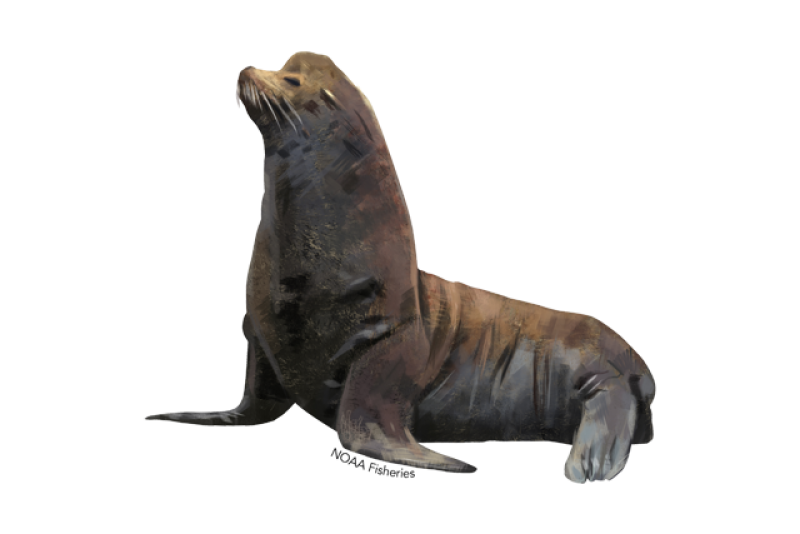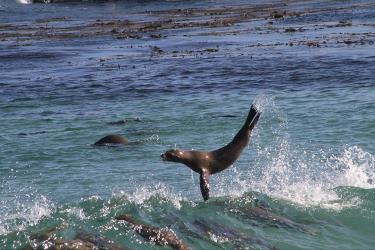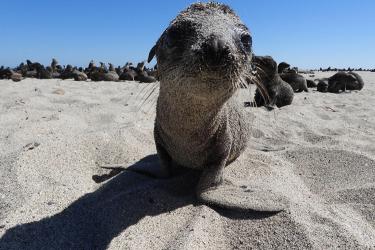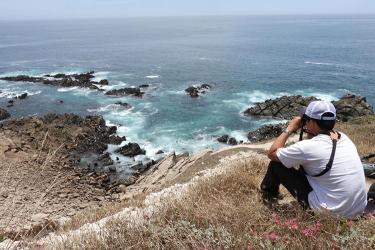Steller Sea Lion
Steller Sea Lion
Eumetopias jubatus
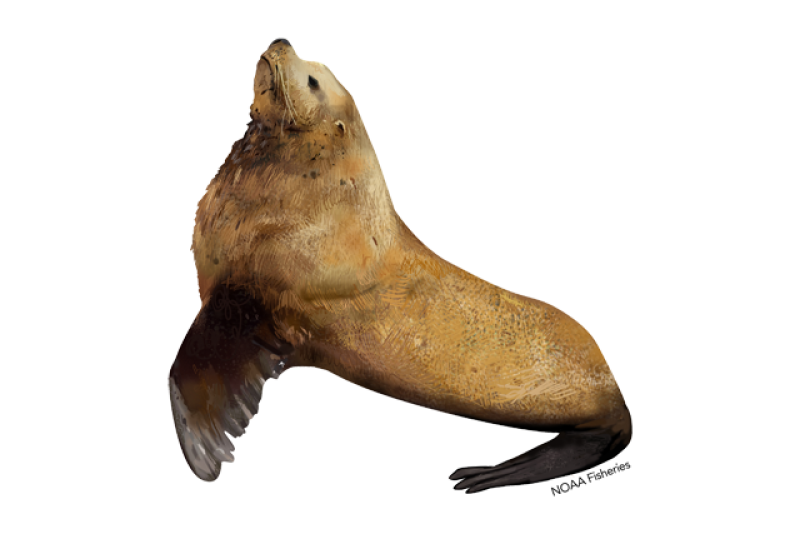
Protected Status
Quick Facts
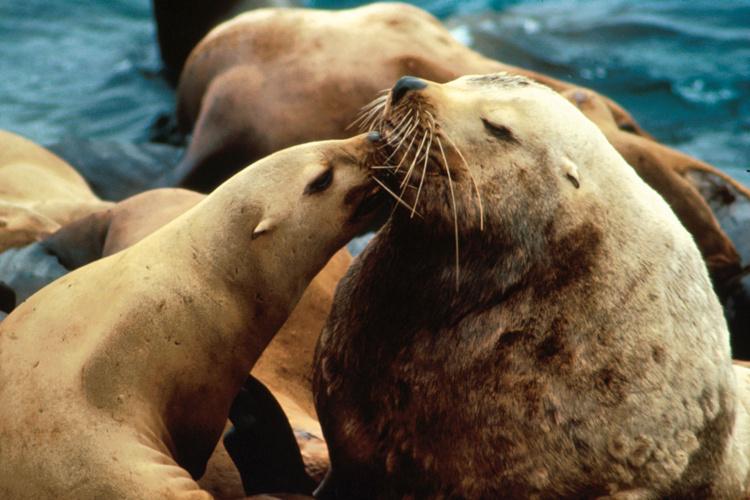 Steller sea lion - Photo: NOAA Fisheries
Steller sea lion - Photo: NOAA Fisheries
Steller sea lion - Photo: NOAA Fisheries
About the Species
 Steller sea lion - Photo: NOAA Fisheries
Steller sea lion - Photo: NOAA Fisheries
Steller sea lion - Photo: NOAA Fisheries
The Steller (or northern) sea lion (Eumetopias jubatus) is the largest member of the family Otariidae, the “eared seals,” which includes all sea lions and fur seals. Steller sea lions are named for Georg Wilhelm Steller, the German surgeon and naturalist on the Bering expedition who first described and wrote about the species in 1742. While they are the only living member of their genus, they share parts of their range with a smaller related species, California sea lions. Steller sea lions' impressive low-frequency vocalizations sound more like roars than California sea lions’ barks. They also share parts of their range with another otariid, the northern fur seal.
Historically, Steller sea lions were highly abundant throughout many parts of the coastal North Pacific Ocean. Indigenous peoples and settlers hunted them for their meat, hides, oil, and other products, and today sea lions are an important subsistence resource for Alaska Natives.
Because of unexplained widespread population declines in Alaska, Steller sea lions were first listed under the Endangered Species Act (ESA) in 1990. In 1997 NOAA Fisheries recognized two distinct population segments, listing the eastern distinct population segment (DPS) as threatened and the western DPS as endangered. The eastern DPS has since recovered and is no longer listed, which is a significant achievement under the ESA. The western DPS remains endangered.
Learn more about the eastern and western populations of Steller sea lions
Population Status
The two populations of Steller sea lions differ genetically and morphologically, and have contrasting population trends. Population status and trends are reported in our stock assessment reports.
The western DPS includes all Steller sea lions originating from rookeries west of Cape Suckling (144° west longitude). Their population has decreased approximately 77 to 81 percent from the 1970s to the early 2000s. While the western DPS has been increasing slowly overall since 2003, there are strong regional differences across the range in Alaska and the population continues to decline in the central and western Aleutian Islands. The North Pacific Ocean marine heatwave of 2014 - 2016 was associated with a decline of pup productivity between 2015 and 2017 in the eastern and central Gulf of Alaska, a decline in adult female survival in the eastern Aleutian Islands, Gulf of Alaska, and Southeast Alaska, and with a subsequent decline in non-pup abundance throughout the Gulf of Alaska in 2019, contrasting with a previously increasing trend until 2017.
The eastern DPS includes Steller sea lions originating from rookeries east of Cape Suckling. The eastern stock increased at a rate of 4.25 percent per year (95 percent credible intervals of 3.77-4.72 percent) between 1987 and 2017, based on an analysis of pup counts in California, Oregon, Washington, British Columbia, and Southeast Alaska.
Population trends for the eastern and western DPSs differ for complex reasons; most simply, the difference likely results from the different kinds and magnitudes of threats the species faces throughout its range.
Appearance
Steller sea lions are sexually dimorphic—adult males are much larger than females. Adult males may be up to 11 feet long and can weigh up to 2,500 pounds. Adult females are 7.5 to 9.5 feet long and weigh up to 800 pounds.
Adult males are further distinguished by long, coarse hair on the chest, shoulders, and back. An adult male’s chest and neck are also more massive and muscular than a female’s. Both adult males and females have light blonde to reddish brown coats that are slightly darker on the chest and abdomen. The light coloration is still visible when the body is wet. Like other pinnipeds, they molt, or shed their fur, every year.
Both sexes have long light-colored whiskers (vibrissae) on their muzzles, which they use to sense prey and feel their way underwater. The flippers and other hairless parts of the skin are black. On land, sea lions, unlike "true" seals, can turn their hind flippers forward for walking. They can climb and are sometimes found on rocks or cliff faces high above the water. When they swim, Steller sea lions use their broad, long front flippers to propel themselves and are highly maneuverable.
Behavior and Diet
Steller sea lions are predatory and consume a wide range of prey, foraging and feeding primarily at night on over a hundred species of fish (including Atka mackerel, walleye pollock, salmon, Pacific cod, Pacific sand lance, arrowtooth flounder, Irish lords, rock sole, capelin, eulachon, Pacific sandfish, Pacific herring, rockfish, smooth lumpsucker, and Pacific hake) and cephalopods (including squid and octopus). Their diet varies in different parts of their range and at different times of the year, depending on the abundance and distribution of prey species. To meet their energy requirements to grow, survive, and reproduce, Steller sea lions likely depend on predictable prey that are readily available and sufficiently abundant so that they may forage efficiently throughout the stages of their lives and during different times of the year.
Steller sea lions forage near and off shore, and in both benthic and pelagic zones. Different individuals may have different foraging strategies. For example, NOAA Fisheries’ research shows that in the non-breeding season, some adult females may spend long periods of time foraging well off the continental shelf while others forage much nearer to terrestrial sites. During the breeding season, a female must forage close enough to her rookery to return often and nurse her young, and her foraging range and trip duration will expand greatly as the pup grows. An adult female has very high energy demands—especially in the winter, when she must find enough food to feed herself and nurse her pup, possibly while pregnant with the next year’s pup.
Steller sea lions, especially males, can travel long distances in a season. Diving ability changes with age. The deepest dive documented is about 1,400 feet in depth.
Steller sea lions need undisturbed land habitat to rest, molt, socialize, mate, give birth, and nurse small pups during the breeding season. They are highly social and may rest in large groups, overlapping their bodies. At sea, they can be seen alone or in small groups, and sometimes gather in large "rafts" at the surface near areas of large prey aggregations. While at sea, they can sometimes be seen holding one or more flippers out of the water to thermoregulate. Flippers are a poorly insulated part of the body because the blood vessels are close to the surface of the skin. When floating on the surface of the water, sea lions can extend their flippers into the air to absorb heat, which is then circulated to the rest of the body, including areas near important seasonal prey resources.
Where They Live
Steller sea lions inhabit the colder temperate to subarctic waters of the North Pacific Ocean. They need both terrestrial and aquatic habitats. They mate and give birth on land, at traditional sites called rookeries. Typically, sea lions come back to mate on their natal rookery site, each year. Sites where animals haul-out to rest, where breeding does not occur, are referred to as haulouts. Haulout and rookery sites usually consist of beaches (gravel, rocky, or sand), ledges, and rocky reefs. In the Bering Sea and Okhotsk Sea, sea lions may also haul-out on sea ice.
Steller sea lions are distributed mainly around the coasts along the North Pacific Ocean rim from northern Hokkaido, Japan through the Kuril Islands and Sea of Okhotsk, the Aleutian Islands and Bering Sea, the southern coast of Alaska, and south to central California. While they are most typically found in coastal waters on the continental shelf, they also occur and sometimes forage in much deeper continental slope and pelagic waters, especially in the non-breeding season.
The western DPS includes Steller sea lions that originate from rookeries west of 144° west longitude (Cape Suckling): those in the Gulf of Alaska, the Aleutian Islands, the Bering Sea, and Asia. The eastern DPS includes sea lions originating from rookeries in Southeast Alaska, British Columbia, Washington, Oregon, and California. Data show that the foraging ranges of the two DPSs overlap, especially in the non-breeding season. For example, females from the eastern Gulf of Alaska regularly occur in parts of Southeast Alaska and males from the eastern DPS have been observed as far north as the Bering Sea. In recent years, a “mixing zone” has also become established in northern southeast Alaska on at least two new rookeries partially established by western DPS females.
Learn more about the eastern and western populations of Steller sea lions
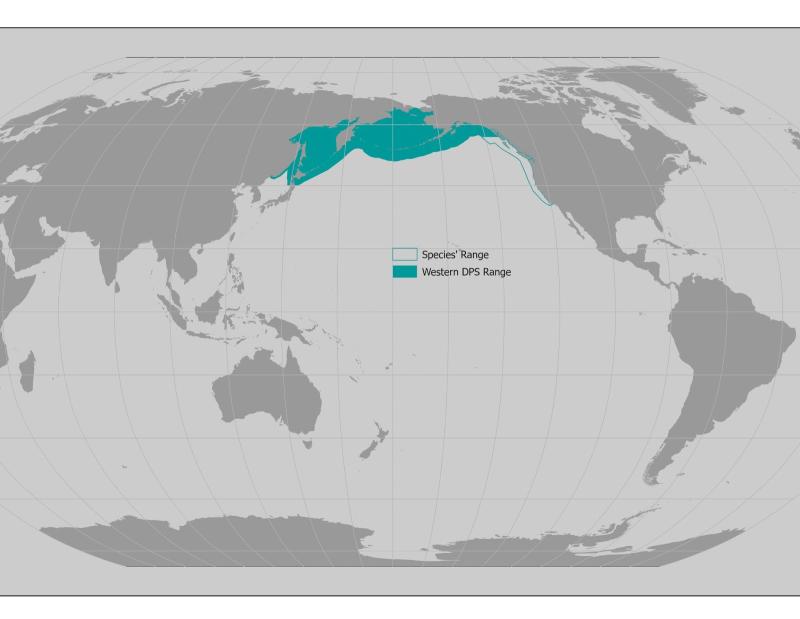 World map providing approximate representation of the Steller sea lion's range.
World map providing approximate representation of the Steller sea lion's range.
Lifespan & Reproduction
Steller sea lions are colonial breeders. They have a polygynous mating system, in which only a small proportion of the sexually mature males father most of the pups in a given season.
Adult males, also known as bulls, arrive early on rookeries to establish breeding territories that they defend through the breeding season. Bulls become sexually mature between 3 and 8 years of age, but typically are not large enough to hold territory successfully until 9 or 10 years old. A mature male may go without eating for 1 to 2 months while he defends his territory. Not all males will successfully hold a breeding territory for one or more breeding seasons.
Females begin to arrive on rookeries in mid-May. Females typically give birth to their first pup between 4 to 6 years of age, usually giving birth to a single pup each year. However, they may not pup every year. Pupping occurs from about mid-May to mid-July and peaks in June. Females usually mate within 2 weeks after giving birth. Steller sea lions are mammals; adult females, also known as cows, stay with their pups for a few days after birth before beginning a regular routine of foraging at sea, nursing pups on land, then going back to forage. Female Steller sea lions use smell and distinct vocalizations to recognize and create strong social bonds with their newborn pups. While most pups likely wean before their first birthdays, some pups are nursed for as long as three years.
At birth, pups are about 3 feet in length and weigh 35 to 50 pounds. Pups have a thick, dark brown to black "lanugo" coat until 4 to 6 months old, when they molt to a lighter brown. By the end of their second year, pups are the same color as adults. Males can live to be up to 20 years old, while females can live to be approximately 30 years old.
Threats
Steller sea lions are exposed to a variety of human-caused and natural threats. Some of the most pressing threats are discussed below.
Effects of Fisheries on Prey
Cumulative and annual commercial fishery removals may result in temporal and seasonal changes in distribution and abundance of primary prey, prey reduction, and changes in prey size; they may also cause ecosystem effects. All of these may affect Steller sea lions' ability to reliably access sufficient prey to sustain the health, reproduction, and survival of individuals and support sustained increase and eventual recovery of the population.
Climate Change
Global climate change is expected to have profound impacts on arctic and sub-arctic marine ecosystems. This may affect the composition, spatial and temporal distribution, and abundance of prey available to Steller sea lions.
Sea Level Rise
Sea level rise caused by climate change will directly affect terrestrial rookery and haulout sites currently used by Steller sea lions as well as those that may be used by a recovering population. This may result in more deaths among small pups, and traditional sites on some islands with low relief may be submerged.
Temperature Changes
Decadal scale regime shifts, and shorter-term oceanographic anomalies such as El Niño Southern Oscillation (ENSO) events and marine heatwaves, also can have large effects on distribution and abundance of Steller sea lion prey. Marine heatwaves have already shown to reduce Steller sea lion survival.
Ocean Acidification
Ocean acidification effects on Steller sea lions are uncertain but are likely to include serious impacts on ecosystems and may have adverse effects on specific species prey through food web effects.
Harmful Algal Blooms
Harmful algal bloom (HAB) toxins cause sickness and death in humans and Steller sea lions. Warming water temperatures increases toxic algae growth, prevents water from mixing, allowing algae to grow thicker and faster, and algal blooms absorb sunlight, making water even warmer and promoting more blooms.
Disease and Parasites
Steller sea lions are exposed to a variety of diseases and parasites. Adult females and pups are likely the age-classes most vulnerable to disease and parasitism. Infectious disease and parasitism likely have a relatively low impact on the recovery of the Steller sea lion's western distinct population segment. However, climate-change-related shifts in distribution of other species may expose Steller sea lions to novel disease vectors or parasites that could have large-scale impacts. NOAA Fisheries works with a variety of scientists and veterinarians to monitor disease in animals that are found dead and to sample live animals.
Toxic Substances
Contaminants that might harm Steller sea lions can occur naturally in the environment and enter ocean waters from many sources, such as oil and gas activity (tankering and pipeline transport, production, etc.), vessel accidents and sinkings (leading to loss of cargo, fuel, etc.), local industrial development, atmospheric transport, wastewater discharges, at-sea processing, runoff, toxic waste sites, nuclear testing, industrial accidents, and natural sources. Once in the environment, some contaminants move up the food chain and accumulate in top predators. Certain pollutants that Steller sea lions are exposed to have been shown to damage the immune and reproductive systems of other mammals and to negatively impact their health and survival. Of particular concern now is information showing that mercury contaminant loads of some western DPS Steller sea lion pups are relatively high in some parts of the range where declines are still occurring. Exposure to organochlorines known to affect health impacts in other species have been found in parts of the western and eastern DPSs, though impacts on Steller sea lions are not clear. Emerging environmental contaminants, such as Polybrominated diphenyl ethers (PBDEs) are known to bioaccumulate in marine mammals and thus are also a concern, though Steller sea lion exposure to these compounds is not well understood.
Human-Caused Injuries and Mortality
Steller sea lions may be disturbed by humans in vessels (power, kayak, etc.), manned and unmanned (e.g. drone) aircraft, and on land. When disturbed, Steller sea lions may stampede into the water, which can injure or kill pups and juveniles when they are crushed by adults, and in extreme cases cause pup abandonment. Steller sea lions that are illegally fed can cause them to become habituated, aggressive, lead to more fisheries interactions, entanglements, and illegal shootings as a result of increased frustrations.
Interactions with Active Fishing Gear
Historically, commercial fishing in the Bering Sea and the North Pacific Ocean incidentally killed many Steller sea lions. Changes in fishing techniques and areas and times fished are thought to have significantly reduced incidental take. Amendments to the Marine Mammal Protection Act in 1988 and 1994 required observer programs to monitor marine mammal incidental take in some domestic fisheries and NOAA Fisheries provides estimates of mortality and serious injury of Steller sea lions due to US commercial fisheries in marine mammal stock assessments for the western and eastern DPSs. These estimates are likely an underestimate of the actual levels, since large segments of the fishing industry, (including fisheries near Steller sea lion rookeries, haulouts, and feeding areas, and fisheries with known past interaction with sea lions) have either no or very limited observer coverage. Thus, we are highly uncertain about the impact of this threat.
Disturbance
Steller sea lions may be disturbed by vessels (power boats, kayaks, paddleboards, etc.) approaching from the water, by manned and unmanned (e.g., drones) aircraft, and by approach from the land. Disturbance to Steller sea lions on terrestrial haulout sites can lead to individuals fleeing toward the water, causing mass stampedes during which pups and juveniles may be injured or killed when crushed by adults. Disturbance can also cause sea lions to flee from the tops of steep rocks or cliff faces, also causing injury or death. Disturbance can lead to interruption of important behaviors such as nursing, resting, breeding, and socializing. Repeated disturbances that cause lactating females to abandon rookeries or use them less often could impact the health and survival of pups by reducing normal nursing cycles. Steller sea lion feeding can also be disturbed by vessel traffic or underwater noise
Entanglement
"Entanglement" in marine debris and/or ingestion of fishing gear is known to contribute to Steller sea lion injury and mortality. Steller sea lions can become entangled in marine debris or fishing gear, by swallowing hooks, swimming off with the gear attached, or becoming anchored. Once entangled, sea lions may drag and swim with attached gear for long distances, ultimately suffering fatigue, compromised feeding ability, or severe injury that may lead to reduced reproductive success and death.
Available data indicate that the incidence of entanglement is greater in Southeast Alaska than in areas west of 144° west longitude. Entanglement rates to the west however are likely underestimated due to fewer observations in a less-populated area. Not all entangled animals strand (e.g., they may drown) and not all stranded animals are found or reported. This is true especially in the most remote parts of the range of this species. Many entanglements are preventable. Learn more in the “Lose the Loop” 60-second video.
Illegal Feeding
Feeding of sea lions is illegal and can lead to close interactions between humans and sea lions that pose risks to both. Feeding-related problems include changes in sea lion behavior; habituation; aggression toward humans; negative impacts to fisheries; and entanglement, injury, and death of animals. Learn more in the “Take the lead, do not feed” 45-second video.
Illegal Shooting
It is illegal to shoot Steller sea lions unless you are an Alaska Native and the take is for subsistence purposes (food or handicraft) and is not accomplished in a wasteful manner. Historical accounts, especially associated with fisheries, documented substantial mortality to the western DPS due to illegal shooting. While there is likely much less illegal shooting than during the period of sharp decline in the 1970s and 1980s, documented illegal shooting of sea lions in the Copper River Delta area, as well as fishermen’s reports of greater interactions with fisheries are cause for concern. Subsistence use of struck and lost Steller sea lion carcasses sometimes further complicate efforts to estimate illegal shooting. Most parts of the range of the western DPS are not systematically monitored for carcasses, so there are no current studies evaluating levels of illegal shooting; large parts of the fishing industry, including fisheries near Steller sea lion rookeries, haulouts, and feeding areas, have either no or very limited observer coverage.
Vessel Strikes
Inadvertent vessel strikes can injure or kill Steller sea lions. There have been four documented cases of Steller sea lions being injured or killed due to nearshore vessel strikes in Alaska since 2007 (PDF: see Table 10). Nearshore vessel strikes are most likely to occur in areas where Steller sea lions are concentrated for feeding or rafting, or near large haulouts or rookeries from which large numbers of animals will be in transit.
Predation
The primary predators of Steller sea lions are killer whales, sharks, and humans.
Scientific Classification
| Kingdom | Animalia | Phylum | Chordata | Class | Mammalia | Order | Carnivora | Family | Otariidae | Genus | Eumetopias | Species | jubatus |
|---|
Last updated by NOAA Fisheries on 05/22/2025
What We Do
Conservation & Management
NOAA Fisheries is committed to the protection and recovery of Steller sea lions. Our work includes:
- Implementing and enforcing special prohibition regulations for the western distinct population segment
- Reviewing projects that could potentially harm Steller sea lions
- Working with non-fishing entities whose actions may incidentally take Steller sea lions to mitigate and monitor that take
- Working with Alaska Native partners regarding subsistence use, monitoring and reporting
- Implementing the Steller Sea Lion Recovery Plan
- Implementing actions identified in the Post-Delisting Monitoring Plan for the eastern DPS
- Regularly assessing the species’ status to determine if current protections need to be modified
- Designating and reviewing Steller sea lion critical habitat
- Responding and planning for oil spills
- Overseeing marine mammal health and stranding response
- Educating, listening to, and working with the public to reduce threats and provide outreach about Steller sea lions.
- Monitoring population trends, distribution, and health
- Working with the fishing industry to reduce or eliminate injury and mortality caused by fisheries and fishing gear
- Taking actions to minimize effects of disturbance
- Continuing a ban on direct takes (unless it is non-wasteful take by coastal Alaska natives for subsistence or the making of handicrafts, or authorized)
Science
Our research has helped inform us about new aspects of Steller sea lion biology, behavior, and ecology and better understand the threats to Steller sea lion individuals and populations. Continued research is especially important in recovering the endangered western DPS and sustaining the recovery of the delisted eastern DPS. Our work includes:
- Stock assessment—determining the status of Steller sea lion populations
- Vital rates—age-specific survival, age of first reproduction, reproductive rates, demography, movements
- Genetic studies
- Monitoring foraging behavior
- Investigating the impacts of contaminants and disease
- Evaluating habitat use and habitat quality
- Analyzing food habits
- Studying other aspects of Steller sea lion ecology needed to understand what is needed to recover the western DPS and sustain the recovery of the eastern DPS
- Determining how marine debris and fishery interactions impact populations
How You Can Help
Obey Steller Sea Lion–Specific Regulations
Under the ESA, most western DPS rookeries are protected by no-entry buffer zones that prohibit entry, with some exceptions, by sea and on land.
Do not discharge a firearm at or within 100 yards of a Steller sea lion west of 144° west longitude. A firearm is any weapon, such as a pistol or rifle, capable of firing a missile using an explosive charge as a propellant.
Learn more about special protections for western DPS Steller sea lions
Keep Your Distance
Be responsible when viewing Steller sea lions in the wild. Steller sea lions can be injured or killed if they are disturbed when they are hauled out. Individuals may unexpectedly panic and flee to the water; a group may stampede and pups or juveniles can be crushed. Even adults can be injured or killed. Disturbing Steller sea lions that are resting, nursing, feeding, or engaged in other key behaviors can reduce the chance that they will survive or reproduce. Their reaction to people is hard to predict. Play it safe—make sure not to disturb Steller sea lions that are hauled out on land or in the water. On the water, observe Steller sea lions from a safe distance of at least 100 yards and limit your time spent observing to 30 minutes or less. If they are hauled out, do not approach close enough to disturb them. If they are rafting, do not approach. Do not enter no-entry buffer zones around specified rookeries
Steller sea lions are also vulnerable to disturbance by air and they have been observed to stampede in response to helicopters more than a mile away. All aircraft need to ensure they do not disturb Steller sea lions.
Report Marine Life in Distress
In Alaska, report a sick, injured, entangled, stranded, or dead marine mammal to the Alaska Marine Mammal Stranding Hotline at (877) 925-7773 to make sure professional responders and scientists know about it and can take appropriate action. Numerous organizations around Alaska are trained to receive reports and respond when necessary.
On the west coast of the U.S., please contact the West Coast Region Stranding Hotline at (866) 767-6114.
Other reporting hotlines and resources:
- To report entangled marine mammals:
- Entanglement Reporting Hotline: 1-877-SOS-WHAL or 1-877-767-9425
- The U.S. Coast Guard: VHF Ch. 16
- To report derelict gear:
- Derelict Gear Hotline: 1-855-542-3935
- Regional stranding response contacts
Report a Violation
Call the NOAA Fisheries Enforcement Hotline at (800) 853-1964 to report a federal marine resource violation. This hotline is available 24 hours a day, 7 days a week for anyone in the United States.
You may also contact your closest NOAA Office of Law Enforcement field office during regular business hours.
Featured News
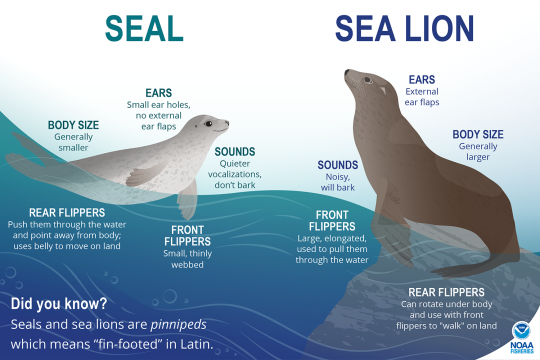 At first glance, seals (true or “earless seals”) and sea lions look fairly similar. Taking a closer look, these are some of the general differences to tell these animals, such as on the harbor seal (left) and California sea lion (right) pictured above.
At first glance, seals (true or “earless seals”) and sea lions look fairly similar. Taking a closer look, these are some of the general differences to tell these animals, such as on the harbor seal (left) and California sea lion (right) pictured above.
Is It a Seal or a Sea Lion?
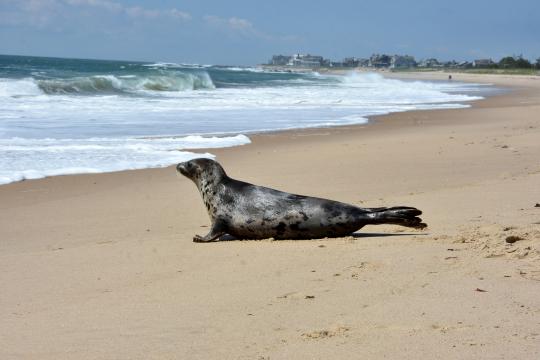 "Seuss," a juvenile harp seal, was released on Blue Shutters Beach, Rhode Island, following successful rehabilitation at Mystic Aquarium. Credit: Mystic Aquarium
"Seuss," a juvenile harp seal, was released on Blue Shutters Beach, Rhode Island, following successful rehabilitation at Mystic Aquarium. Credit: Mystic Aquarium
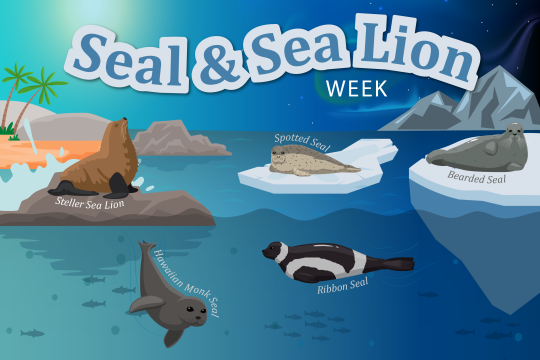 Seal & Sea Lion Week is March 11-15, 2024.
Seal & Sea Lion Week is March 11-15, 2024.
Seal and Sea Lion Week
 This is a path diagram for the Bering Sea and Aleutians Islands marine ecosystem. It shows linkages between ecosystem variables. Arrows correspond to suspected relationships. An arrow pointing from X to Y indicates that a change in X is estimated to cause a change in Y. The number next to each arrow shows the estimated magnitude of the change (red arrows indicate a negative change and blue arrows indicate a positive change).
This is a path diagram for the Bering Sea and Aleutians Islands marine ecosystem. It shows linkages between ecosystem variables. Arrows correspond to suspected relationships. An arrow pointing from X to Y indicates that a change in X is estimated to cause a change in Y. The number next to each arrow shows the estimated magnitude of the change (red arrows indicate a negative change and blue arrows indicate a positive change).
Eastern and Western Populations
The decline in the abundance of Steller sea lions was first observed in Alaska in the 1970s, and the rate of decline increased dramatically in the late 1980s. This decline prompted NOAA Fisheries to list the species range-wide as threatened under the ESA in 1990. Due to genetic, morphological, ecological, and population trend data supporting the overall distinctiveness, NOAA Fisheries recognized two distinct population segments (DPS) in 1997.
The two recognized DPSs are:
- The western DPS, which includes all Steller sea lions originating from rookeries west of Cape Suckling (144° west longitude). The western DPS’s ESA listing status was elevated to endangered when it was established, due to lack of recovery; it remains listed as endangered today. Western DPS Steller sea lions also occur east of 144° west longitude in a “mixing zone” in central and northern Southeast Alaska.
- The eastern DPS, which includes Steller sea lions originating from rookeries east of Cape Suckling (144° west longitude). The eastern DPS retained its threatened listing status under the ESA when it was established. By 2013, it demonstrated 30 years of recovery leading NOAA Fisheries to delist it.
Threats vary throughout the range of each DPS and vary over time. Some of the threats that led to an Endangered Species Act listing are better controlled, but new threats may be present or emerging. Some of the most pressing threats are discussed under the Overview tab.
Western DPS
While the western population has been increasing slowly overall since about 2003, it continues to decline rapidly in large areas of its range (central and western Aleutian Islands regions). Recent changes in counts in other areas that were showing signs of recovery (eastern and central Gulf of Alaska regions) are of high concern, and evidence as a whole indicates that there are multiple remaining threats to their existence.
Eastern DPS
Intentional killing, such as predator control and commercial harvests in large areas of the range of the eastern population, resulted in major reductions in abundance through much of the 1900s. Culling and commercial harvests in Alaska (prior to the Marine Mammal Protection Act), competition with fisheries for prey, incidental take in fisheries, entanglement, legal and illegal shooting, and possibly other factors also adversely affected Steller sea lions. Intentional killing of Steller sea lions with certain exceptions (non-wasteful take by coastal Alaska Natives for subsistence and the making of handicrafts, take authorized under a marine mammal research permit, take by a government official under select circumstances) is illegal.
International Protections
Steller sea lions are protected in Canada, where they are categorized as a Species of Special Concern, and in Russia, where they are listed as an endangered species under Russian legislation. NOAA Fisheries coordinates with Fisheries and Oceans Canada to monitor British Columbia populations. While the Russian government currently has no organized program of monitoring and research, NOAA Fisheries supports projects monitoring population trends and vital rates in Russia. In return, NOAA Fisheries receives high-value information needed to understand the overall status of the western population and threats to its long-term survival.
More Information
Last updated by NOAA Fisheries on 05/22/2025
Management Overview
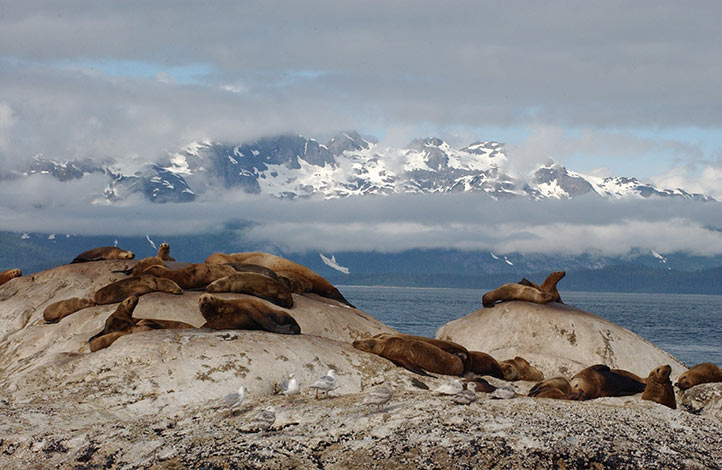
Steller sea lions in Southeast Alaska. Photo: Alaska Department of Fish and Game
The Steller sea lion Western distinct population segment (DPS) is listed as endangered under the Endangered Species Act.
The Steller sea lion is protected throughout its range under the Marine Mammal Protection Act.
The Western DPS is depleted under the Marine Mammal Protection Act.
The western distinct population segment (DPS) is listed as endangered under the ESA and, therefore, also designated as depleted under the MMPA. As a result, the stock is classified as a "strategic stock".
NOAA Fisheries has a responsibility under the ESA to take action to conserve Steller sea lions, that is, to use all methods and procedures that are necessary to bring the endangered western DPS to the point at which ESA protections are no longer necessary, and to sustain the eastern DPS's recovery. NOAA Fisheries, state, international, university, tribal, other federal, and other scientists use a variety of innovative techniques to better understand Steller sea lion ecology and threats to their long-term viability. Working with our many partners, NOAA Fisheries scientists use this information to identify actions to remove or reduce threats.
The overall framework and priorities for research and management actions for the western population are described in the Steller Sea Lion Recovery Plan and modified, if needed, based on the best available scientific information. The framework and priorities for monitoring for the eastern population are described in the eastern DPS post-delisting monitoring plan.
Recovery Planning and Implementation
Recovery Action
Under the ESA, NOAA Fisheries is required to develop and implement recovery plans for the conservation and survival of listed species.
NOAA Fisheries published the first recovery plan for the Steller sea lion in 1992. In 2008, NOAA Fisheries issued a revised recovery plan for both DPSs. These plans were developed with the assistance of recovery teams.
The 2008 Plan specifies:
- Site-specific management actions needed to achieve the plan's goal for the conservation and survival of the species
- Objective, measurable criteria for removing the species from the list, in accordance with the ESA
- Estimates of the time and cost needed to carry out measures to achieve the plan's goal and to reach intermediate steps toward that goal
The Plan identifies major action categories related to the western DPS, aimed at achieving four broad goals:
- Ensure adequate habitat and range for recovery
- Protect from overutilization for commercial, recreational, scientific, or educational purposes
- Protect from diseases, contaminants, and predation
- Protect from other natural or anthropogenic actions and administer the recovery program
While the Plan identifies many specific recovery actions for the western DPS, it highlights four actions as especially important:
- Continue population modeling and research on the key threats potentially impeding sea lion recovery
- Maintain current or equivalent level of fishery conservation measures
- Design and implement an adaptive management program to evaluate fishery conservation measures
- Develop an implementation plan
For the eastern DPS, the Plan recommended that NOAA Fisheries conduct a status review to determine if the DPS should be delisted. This was accomplished and the eastern DPS was delisted in late 2013.
Implementation
Together with our partners, NOAA Fisheries is undertaking numerous activities to support the goals of the Steller sea lion recovery plan, and to implement the many actions identified in it. Ultimately, we seek to have the species recover so the ESA protections are no longer needed to stave off its extinction.
Learn more about the implementation of the Steller Sea Lion Recovery Plan
Efforts to conserve Steller sea lions include:
- Implementation and enforcement of special prohibitions aimed at protecting the Steller sea lions and their rookeries
- Protection against unauthorized take under the ESA and MMPA
- Consultation with other federal agencies under Section 7 of the ESA to avoid jeopardy to the species and adverse modification or destruction of their designated critical habitat
- Evaluation of actions seeking authorization of incidental take of Steller sea lions under the MMPA and identification of measures to mitigate impacts
- Monitoring of incidental take of Steller sea lions in federal fisheries and estimation of total human-caused lethal take and serious injury
- Collaboration with Alaska Native organizations to conserve Steller sea lions and provide for co-management of subsistence use by Alaska Natives. These activities have included collaborative exchanges of information, education, and outreach; collection of biological samples from harvested animals to further research into threats and status; monitoring of habitat use; harvest monitoring; and other activities
- Education and outreach about regulations, laws, subsistence hunting, status, research, and threats
- Protecting habitat and designating critical habitat
- Reducing bycatch
- Entanglement response
Critical Habitat Designation
Once a species is listed under the ESA, NOAA Fisheries evaluates and identifies whether any areas meet the definition of critical habitat. Those areas may be designated as critical habitat through a rulemaking process. The designation of an area as critical habitat does not create a closed area, marine protected area, refuge, wilderness reserve, preservation, or other conservation area; nor does the designation affect land ownership. Federal agencies that undertake, fund, or permit activities that may affect these designated critical habitat areas are required to consult with NOAA Fisheries to ensure that their actions do not adversely modify or destroy designated critical habitat.
In 1993, NOAA Fisheries designated critical habitat for Steller sea lions range-wide in the United States. Critical habitat included all Steller sea lion rookeries and major haulouts (i.e., haulouts supporting > 200 Steller sea lions) located within state and federally managed waters off Alaska; a terrestrial zone that extends 3,000 feet (0.9 km) landward from the baseline or base point of each major rookery and major haulout in Alaska; an air zone that extends 3,000 feet (0.9 km) above the terrestrial zone of each major rookery and major haulout in Alaska, measured vertically from sea level; an aquatic zone that extends 3,000 feet (0.9 km) seaward in State and Federally managed waters from the baseline or basepoint of each major rookery and major haulout in Alaska east of 144° W. longitude; an aquatic zone that extends 20 nm (37 km) seaward in State and Federally managed waters from the baseline or basepoint of each major rookery and major haulout in Alaska that is west of 144° W. longitude; and three special aquatic foraging areas in Alaska, including the Shelikof Strait area, the Bogoslof area, and the Seguam Pass area. In California and Oregon, Steller sea lion critical habitat includes all major rookeries and associated air and aquatic zones. Similar to Alaska, critical habitat includes an air zone that extends 3,000 feet (0.9 km) above areas historically occupied by sea lions, measured vertically from sea level, and an aquatic zone that extends 3,000 feet (0.9 km) seaward in State and Federally managed waters from the basepoint of each major rookery. Major rookeries in Oregon include Pyramid Rock (Rogue Reef), and Long Brown Rock and Seal Rock (Orford Reef). In California, major rookeries include Saint George Reef/South Seal Rock, Año Nuevo Island, Southeast Farallon Island, Sugarloaf Island and Cape Mendocino.
NOAA Fisheries is currently reviewing existing Steller sea lion critical habitat to take into account any new and pertinent sources of information since the 1993 designation, including the delisting of the eastern DPS.
Critical habitat maps for Steller sea lions:
- Steller Sea Lion Western DPS Critical Habitat Map and GIS data
- Alaska ESA Species and Critical Habitat Mapper Web Application
- California and Oregon SSL Critical Habitat Map (PDF)
- Western-Southcentral Alaska SSL Critical Habitat Map (PDF)
- Southeast Alaska SSL Critical Habitat Map (PDF)
- Shapefiles - SSL Critical Habitat AK, CA, OR
Coordinates:
Conservation Efforts
5-Year Status Review
In December 2017, NOAA Fisheries initiated a 5-year status review of the endangered western DPS of Steller sea lion under the ESA. The public comment period was extended in February 2018, it was sent out for external peer review in April 2019, and the completed status review was published in February 2020. The ESA requires us to conduct these 5-year status reviews to ensure that the listing classifications of species are accurate. This 5-year status review was based on the best current scientific and commercial data available.
Implementing Measures to Protect Steller Sea Lions and Their Critical Habitat from Certain Groundfish Fisheries
The groundfish fisheries off Alaska target several Steller sea lion prey species, which can negatively impact Steller sea lions and their critical habitat. After consultation under Section 7 of the ESA, NOAA Fisheries developed and implemented measures to avoid jeopardizing the continued existence of the western DPS and harming or destroying designated critical habitat. These measures include commercial fishery timing and spatial restrictions to reduce impacts to Steller sea lion prey; area closures to reduce impacts to prey habitat and distribution and disturbance to Steller sea lions (e.g., pupping, nursing, breeding, resting, regulating temperature, and socializing) on or near their terrestrial habitat, and the potential for stampedes or other disturbance-caused behaviors that may lead to Steller sea lion injury death. Literature also suggests that some protected zones may also have long-term positive impacts on ecosystem function.
Learn more about fishery protection measures
Reducing Disturbance
As a minimum protective measure put in place at the time of listing, NOAA Fisheries implemented no-entry buffer zones around many of the rookeries in parts of the range now recognized as breeding habitat for the western DPS. While these protections serve several functions, they were designed in part to protect the species from being disturbed at their most sensitive sites. The current level of disturbance of sea lions at rookeries and haulouts is not known, and more information is needed about potential effects of repeated disturbance on the health, reproduction, and survival of Steller sea lions.
Protections Against Shooting
As a minimum protective measure at the time of listing, NOAA Fisheries implemented special protections against shooting. West of 144° west longitude, it is illegal to discharge a firearm at or within 100 yards of a Steller sea lion. This prohibition does not apply to coastal Alaska Natives when they are engaged in non-wasteful hunting of Steller sea lions primarily for subsistence.
Overseeing Marine Mammal Health and Stranding Response
We work with volunteer networks in all coastal states to respond to marine mammal strandings including all pinnipeds. When stranded animals are found alive, NOAA Fisheries and our partners assess the animal’s health and determine the best course of action. When stranded animals are found dead, our scientists work to understand and investigate the cause of death. Although the cause often remains unknown, scientists can sometimes attribute strandings to disease, harmful algal blooms, vessel strikes, fishing gear entanglements, pollution exposure, and underwater noise. Some strandings can serve as indicators of ocean health, giving insight into larger environmental issues that may also have implications for human health and welfare.
Learn more about the Marine Mammal Health and Stranding Response Program
Marine Mammal Unusual Mortality Events
Steller Sea Lions have been part of a declared unusual mortality event in the past. Under the Marine Mammal Protection Act, an unusual mortality event is defined as "a stranding that is unexpected; involves a significant die-off of any marine mammal population; and demands immediate response." To understand the health of marine mammal populations, scientists study unusual mortality events.
Key Actions and Documents
Incidental Take Authorization: Oregon Department of Transportation’s Yaquina Bay Dolphin Replacement Project in Newport, Oregon
Incidental Take Authorization: Turnagain Marine Construction's Seward Cruise Ship Passenger Dock and Terminal Facility Project in Seward, Alaska
Incidental Take Authorization: Scripps Institution of Oceanography's Geophysical Surveys in the Cascadia Subduction Zone of the Northeast Pacific
Incidental Take Authorization: U.S. Fish and Wildlife Service, Farallon Islands National Wildlife Refuge's Research, Monitoring, and Management
More Information
Last updated by NOAA Fisheries on 05/22/2025
Science Overview
NOAA Fisheries conducts various research activities on the biology, behavior, and ecology of the Steller sea lion. The results of this research are used to inform management decisions and enhance recovery efforts for this endangered species.
Watch our video about how our scientists are investigating what’s going on with endangered Steller sea lions, learning why some populations of which are declining, while others are thriving.
Stock Assessments
Determining the status of Steller sea lion populations—and whether a stock is increasing or decreasing over time—helps resource managers assess the success of enacted conservation measures. Our scientists collect information and present this data in annual stock assessment reports.
Vital Rates
Our Alaska Fisheries Science Center is collaborating with the Alaska Department of Fish and Game and the Alaska Sea Life Center to collect observations of marked Steller sea lions for ongoing studies of life history and demography. By observing known-age individuals throughout their lives, scientists are able to calculate basic information such as age-specific survival, age of first reproduction, and reproductive rate—all of which are necessary to assess population recovery.
Additional Research
Ongoing research on abundance, movements and vital rates, and diet and foraging behavior helps us understand the role of Steller sea lions in the marine ecosystem and inform management decisions for the conservation of this important species.
Learn more about what our scientists from the Alaska Fisheries Science Center are working on
Last updated by NOAA Fisheries on 05/22/2025
Documents
Biological Opinion (NMFS), Bureau of Land Management National Petroleum Reserve-Alaska Integrated Activity Plan and Arctic National Wildlife Refuge Coastal Plain Oil and Gas Lease Program, North Slope, Alaska
The proposed action would make available specific areas of the NPR-A and Coastal Plain for lease…
Biological Opinion (NMFS), US Army Corps of Engineers, Turnagain Marine Construction, Seward Cruise Ship Passenger Dock Expansion, Seward, Alaska
This opinion considers the effects of in-water pile driving of steel piles, dredging and the…
Biological Opinion Alaska Department of Transportation and Public Facilities (ADOT&PF) Prince William Sound (PWS) Ferry Terminals Improvements Project, Prince William Sound, Alaska
This opinion considers the effects of improvement and modification activities including pile…
Biological Opinion NMFS Office of Protected Resources, Permits and Conservation Division, Whittier Small Boat Harbor, Whittier, Alaska
This opinion considers the effects of in-water pile driving of steel piles and the removal and…
Data & Maps
2025 Results Of Steller Sea Lion Surveys In Alaska
The Alaska Fisheries Science Center’s Marine Mammal Laboratory conducts annual crewed aircraft and…
2024 Results Of Steller Sea Lion Surveys In Alaska
The Alaska Fisheries Science Center’s Marine Mammal Laboratory conducts annual crewed aircraft and…
2023 Results Of Steller Sea Lion Surveys In Alaska
The Alaska Fisheries Science Center’s Marine Mammal Laboratory (MML) conducts annual crewed…
2022 Results Of Steller Sea Lion Surveys In Alaska
The Marine Mammal Laboratory (MML) conducted aerial surveys to photograph and count Steller sea…
Research
Gulf Of Alaska Climate Integrated Modeling Project
Scientists are using an integrated modeling approach to identify factors affecting present and future ecosystem-level productivity and to assess the economic and social impacts on Gulf of Alaska fishing communities of Climate Change.
Alaska Marine Mammal Field Work
NOAA Fisheries Alaska Fisheries Science Center and National Oceanic & Atmospheric Administration conduct research on marine mammals off the coasts of Alaska, Washington, Oregon, and California.
Steller Sea Lion Survey Reports
This page includes links to Steller Sea Lion vessel and aerial survey reports.
Alaska Marine Mammal Observer Program
NOAA Fisheries is not operating the Alaska Marine Mammal Observer Program due to a lack of available resources to fund additional observations of the southeast Alaska salmon drift gillnet fishery. We will reassess future activities as funding permits.
Outreach & Education
California Current Ecosystems Program Flyer
This program is in NOAA Fisheries Alaska's Marine Mammal Laboratory Division.
Alaska Ecosystems Program Flyer
This program is in NOAA Fisheries Alaska's Marine Mammal Laboratory Division.
2025 Aerial Surveys of Steller Sea Lions in the Aleutian Islands, Alaska
Aerial Survey of Steller Sea Lions Research Brief
2024 Aerial Surveys of Steller Sea Lions and Harbor Seals in Alaska
Research Brief for 2024 Aerial Surveys of Steller Sea Lions and Harbor Seals in Alaska
Last updated by NOAA Fisheries on 05/22/2025
